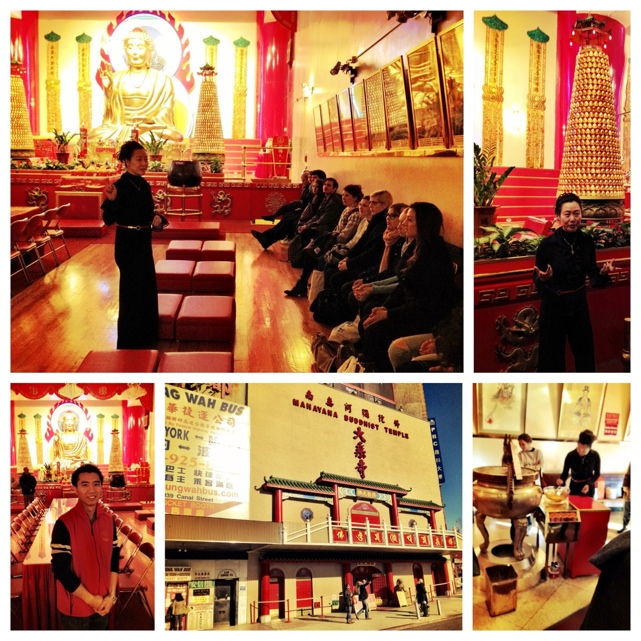We’re used to making magical experiences happen at the Rubin Museum. We have an amazing space, transformative art, and a warm and caring band of educators who try to create meaningful moments with every type of audience imaginable. It is a rare and amazing thing to take part of a transformative environmental experience, and Laura and I were so happy to share a unique moment with our Eugene Lang class at the Mahayana Buddhist Temple.
Laura and I teach a class every Friday at Eugene Lang College, the New School in the Religious Studies department. Our class is called Divine on Display, and it examines the intersection of secular and religious spaces that house religious artifacts. After examining Hindu art and artifacts at the Metropolitan Museum of Art, we’re at a point in our class where we are introducing core tenants of Buddhism. Before looking at the Buddhist works of art in our museum, we thought that a trip to the Mahayana Buddhist Temple would be an exciting experience for our students to see religious artifacts in context. The Temple has one of the largest (if not the largest) Buddha sculptures (we’re talking 16 feet!) in New York City, as well as one of the most interesting locations (at the foot of the Manhattan Bridge). In the heart of NYC’s China Town, the Temple (established in 1997) had been various things over time (including a movie theater), and is now the heart of Buddhism for the Chinatown community. We were incredibly lucky to be guided through the temple by the fabulous Patricia Ying, a member of the Ying family that established an original storefront temple in 1962 just a few blocks away. Ms Ying led us through the core tenants of Buddhism from a Chinese practitioner’s point of view and then showed us in detail how a practitioner would experience the temple and make offerings.
Ms. Ying was the true embodiment of compassion, demonstrating compassion for our students who had so many questions as well as for her daughter who was tagging along for our experience. A young child listening to a lecture at the end of the day on Friday is not one who sits passively by. Ms. Ying’s delicate balance of paying respectful, loving attention to her child as well as our Lang students was true demonstration of the Bodhisattva way.
After our experience at the Temple, we walked to the original storefront Temple located on Mott Street. This was probably the most dangerous part of our trip as Chinatown traffic is not university group friendly.
 The storefront Temple provided a dramatic contrast to the larger center, and was a testament to ingenuity of newcomer New Yorkers to make the best out of little spaces. Established in 1962, the Ying’s created the space to be a meeting spot for Chinese men who had come over during a period of open immigration to the United States. Many of these men had planned to make money quickly and return home but did not count on the Communist Revolution, which stranded them in America. The Temple served as both a meeting place and a Buddhist Temple, and is still used by practitioners.
The storefront Temple provided a dramatic contrast to the larger center, and was a testament to ingenuity of newcomer New Yorkers to make the best out of little spaces. Established in 1962, the Ying’s created the space to be a meeting spot for Chinese men who had come over during a period of open immigration to the United States. Many of these men had planned to make money quickly and return home but did not count on the Communist Revolution, which stranded them in America. The Temple served as both a meeting place and a Buddhist Temple, and is still used by practitioners.




